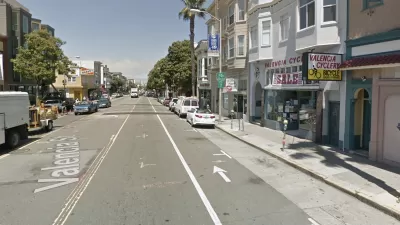Street improvements to benefit cyclists and pedestrians have been moving rapidly in San Francisco since the June approval of the Vision Zero quick-build initiative, a two-year plan to expedite safety project on high-injury corridors.

"A street design revolution is under way in San Francisco’s downtown and waterfront neighborhoods, the bustling heart of the city and the site of many deadly car crashes," writes Rachel Swan, who covers transportation for the San Francisco Chronicle.
The frenzy of quick-build projects represents a culture change at San Francisco Municipal Transportation Agency [SFMTA], long known for its sluggish bureaucracy and inability to overcome political opposition.
"Quick-build projects are reversible, adjustable traffic safety improvements that can be installed relatively quickly," states the SFMTA description of the initiative at the heart of the street design revolution. See slide presentation [pdf].
Unlike major capital projects that may take years to plan, design, bid and construct, quick-build projects are buildable within weeks and months and are intended to be evaluated and reviewed within the initial 24 months of construction.
"In past years, infrastructure as simple as a raised crosswalk or a paint-and-post bike lane would run through a gantlet of community meetings, where residents and merchants would rail about lost parking or the narrowing of a road," adds Swan.
Sometimes neighbors would kill a project all together. Often they would slow it down or significantly alter the plans.
Conversion of conventional to protected bike lane
"And this week [Sept. 17] the board of directors for the SFMTA unanimously approved another protected bike lane along Fifth Street, stretching from Caltrain to Market Street," adds Swan.
On average one person gets injured each week in traffic collisions on Fifth Street, a disturbing trend that the SFMTA hopes to reverse, said agency planner Thalia Leng.
Crews will begin re-striping the street within six weeks, finish concrete work next winter and upgrade intersections in 2021.
The 5th Street Improvement Project fits in well with the Vision Zero Quick-Build initiative in the sense that rather than adding a new, protected bike lane, which would make it more of a long term capital improvement project, SFMTA will upgrade the existing conventional bike lane to a protected lane.
“As it currently exists, 5th Street is simply not designed to keep pedestrians and bicyclists safe," said Mayor London Breed in a news release on Sept. 18.
"This project will protect pedestrians and bicyclists, and our new quick-build policy will allow us to make immediate safety improvements while long-term changes are being made.”
A good example of the MTA turnaround in approaching deadly corridors is the Townsend Corridor Improvement Project by the San Francisco Caltrain Depot, which was shelved last year and is now undergoing construction.
The 7th Street Safety Project was completed last month and is operational, but a critical commentary by Streetsblog SF editor Roger Rudick highlights the differences between the quick-build approach to protected bike lanes and those done as long term capital improvements.
Related in Planetizen:
-
Streamlining Protected Bike Lanes, San Francisco Style, June 4, 2019
-
It Takes a Fatality to Remove On-Street Parking, March 15, 2019
-
Dangerous By Design: Streets Are Only Getting Less Safe for Pedestrians, January 23, 2019
-
Protected Bike Lane Plan Shelved in San Francisco, July 13, 2018
-
Court Ruling Stalls San Francisco Bike Plan, November 10, 2006
FULL STORY: Protected bike lanes approved for Fifth Street, work to begin within 6 weeks

Alabama: Trump Terminates Settlements for Black Communities Harmed By Raw Sewage
Trump deemed the landmark civil rights agreement “illegal DEI and environmental justice policy.”

Study: Maui’s Plan to Convert Vacation Rentals to Long-Term Housing Could Cause Nearly $1 Billion Economic Loss
The plan would reduce visitor accommodation by 25% resulting in 1,900 jobs lost.

Planetizen Federal Action Tracker
A weekly monitor of how Trump’s orders and actions are impacting planners and planning in America.

Paris Bike Boom Leads to Steep Drop in Air Pollution
The French city’s air quality has improved dramatically in the past 20 years, coinciding with a growth in cycling.

Why Housing Costs More to Build in California Than in Texas
Hard costs like labor and materials combined with ‘soft’ costs such as permitting make building in the San Francisco Bay Area almost three times as costly as in Texas cities.

San Diego County Sees a Rise in Urban Coyotes
San Diego County experiences a rise in urban coyotes, as sightings become prevalent throughout its urban neighbourhoods and surrounding areas.
Urban Design for Planners 1: Software Tools
This six-course series explores essential urban design concepts using open source software and equips planners with the tools they need to participate fully in the urban design process.
Planning for Universal Design
Learn the tools for implementing Universal Design in planning regulations.
Smith Gee Studio
Alamo Area Metropolitan Planning Organization
City of Santa Clarita
Institute for Housing and Urban Development Studies (IHS)
City of Grandview
Harvard GSD Executive Education
Toledo-Lucas County Plan Commissions
Salt Lake City
NYU Wagner Graduate School of Public Service




























